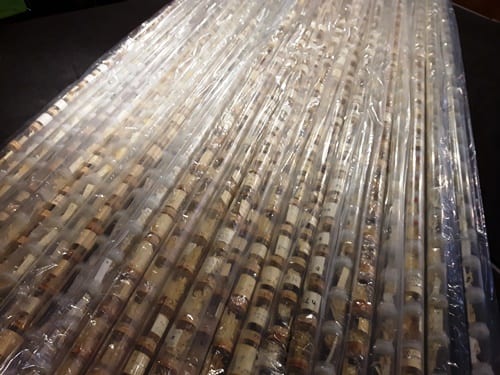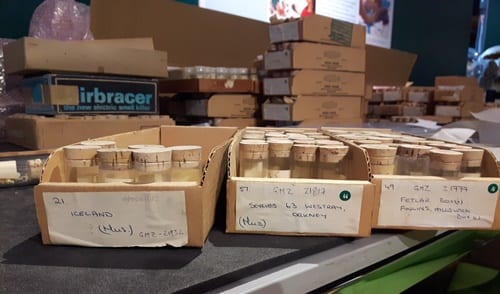Specimen of the Week 321: the Wall of Mice
By Jack Ashby, on 15 December 2017
One of the most extraordinary collections in the Grant Museum relates to one of the most Ordinary of Animals. Since its creation, it has been kept behind the scenes. The man who created it, over decades of barely believable dedication and hard work, would probably never have imagined that anyone would firstly want to display it, and secondly find a way to do so.
Personally, I have a real interest in pondering the differences between what gets selected for display in museums and what doesn’t (I published an article in The Conversation about it this week), and in the Grant Museum we have a lot of experience of finding ways to display collections that were not intended for the public eye (our Micrarium is a great example of this). This week’s Specimen of the Week definitely fits these themes…
**The Wall of 4,000 Mice Skeletons**
Mice Space
At the very centre of our current exhibition, The Museum of Ordinary Animals (which closes on 22nd December so hurry up and see it!) is a wall tiled with around 4,000 loose house mouse skeletons (it’s called Mice Space, for those of you of a certain age), individually housed in little glass vials. If you are curious, this is what 4,000 house mouse skeletons looks like:
We are putting 4000 mice skeletons on display in our #OrdinaryAnimals exhibition.
This is what 4000 mice looks like. pic.twitter.com/8SWEc1kOLa— Grant Museum, UCL (@GrantMuseum) September 14, 2017
Over the course of a very long day, the whole team here poked these vials into 100 perspex tubes in order to create the display.
What’s with all the mice?
Each column in the display (and each box in which they were originally housed), represents a collection of mice from a different island around the world. Many of them are from the Scottish islands, but some come from as far afield as the Sub-Antarctic. They were collected during the 1960s and 1970s by Professor R.J. Berry, who was a zoologist working here at University College London, in order to investigate some of the interesting things that evolution and ecology do to species living on islands.
House mice are a great choice for studying these processes as they are a single species found all around the globe. The species is native to northern India, but these mice have recently been transported all across the planet as stowaways.
Island mice
One topic Berry was investigating was “the Founder Effect” – the idea that populations that are started by a small number of individuals colonising a new area (like an island) will not have the same average genetic make-up of the population they came from (the few pioneers will not represent the full range of variation).
He also used the mice to look at the effect of climate on how body size varies in a single species with a wide range. He was testing Bergmann’s rule, which states that individuals in colder climates will be larger than those in warmer places, as larger animals can retain heat more efficiently because of their surface area to volume ratio. Islands are particularly interesting for this study as they are typically harsher environments than the nearest mainland. Berry found that body size did indeed increase with decreasing temperatures.
Here we are unveiling Mice Space:
MICE SPACE!
Our new exhibition – The Museum of #OrdinaryAnimals – features a wall of 4,000 house mice skeletons. Here’s the grand unveiling: pic.twitter.com/eAGcXQqeGQ— Grant Museum, UCL (@GrantMuseum) September 28, 2017
The Museum of Ordinary Animals runs until 22nd December. Full details are on the exhibition’s website.
Jack Ashby is Manager of the Grant Museum of Zoology.
 Close
Close




